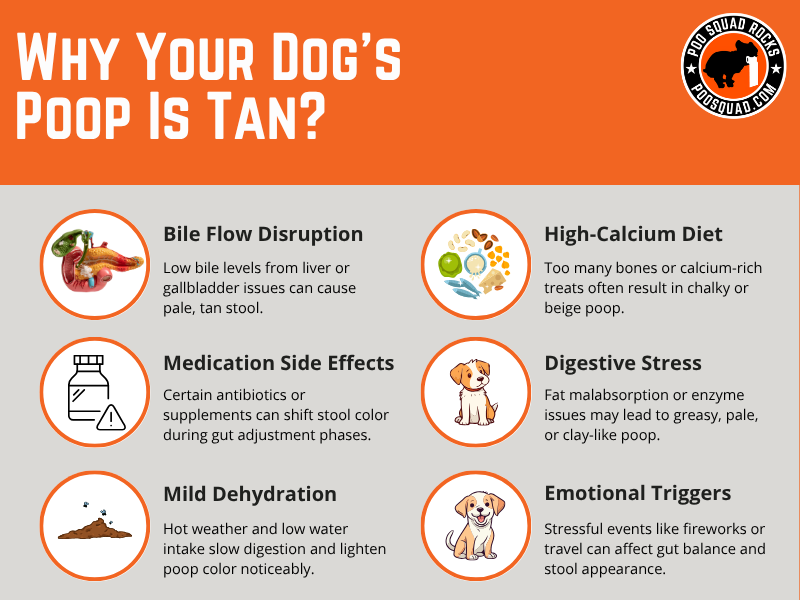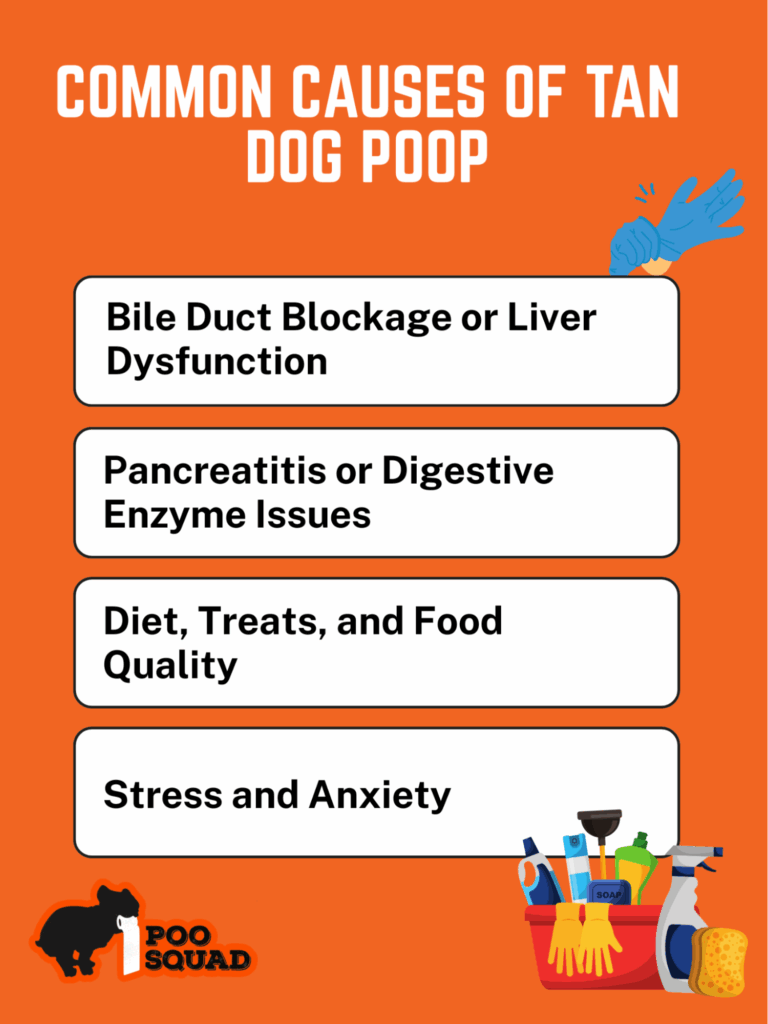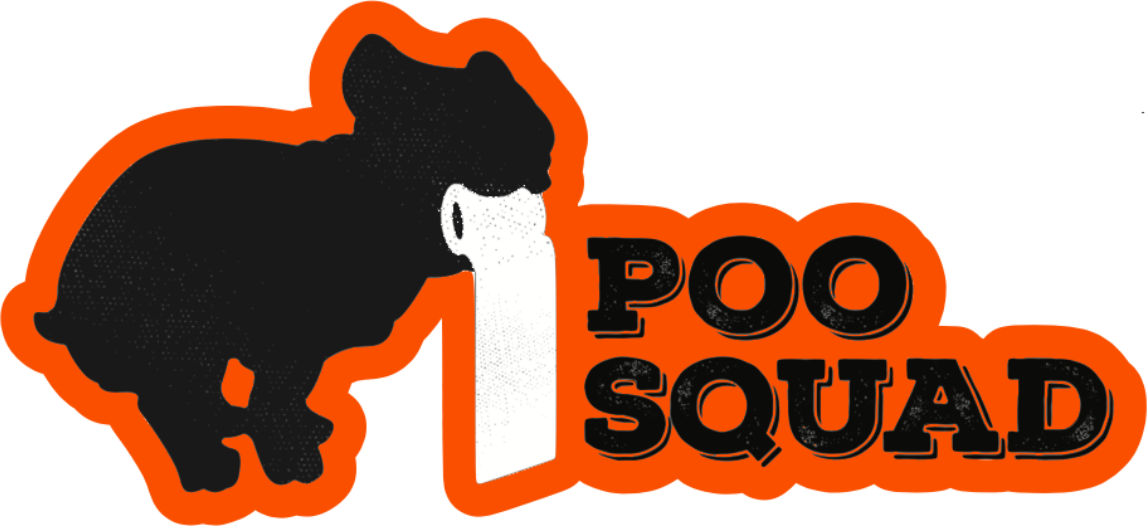Why Is My Dog’s Poop Tan? Causes, Signs & What To Do
Tan dog poop is often caused by low bile output, poor fat digestion, or diet changes. It can be harmless short-term, but if it persists or appears greasy or clay-like, it may signal liver or pancreatic issues. Learn when to monitor and when to call the vet.

Tan dog poop not always an emergency either. While most healthy dogs leave behind dark brown stools thanks to bile from the liver, a pale or beige pile. That can happen from a simple diet change… or from something more serious like liver dysfunction or a blocked bile duct.
When it’s a harmless blip, and when it’s a red flag. We’ll cover common causes like enzyme issues, dehydration, stress, high-calcium diets, and why poop color matters more than most owners realize. You’ll also learn what other symptoms to watch for, how to track changes, and when to call the vet.
For our pet waste clients, tan stool is a signal. That’s why we include poop health flags in every yard report. Because your dog’s digestion is talking.
Are you reading the signs?
What Does Tan Dog Poop Mean?

Healthy dog poop usually shows up in a deep, chocolatey brown, nothing glamorous, but it gets the job done. That color comes from bile, a digestive fluid made by the liver and stored in the gallbladder.
Once your dog eats, bile mixes in to help break down fat and move everything along the digestive highway.
If bile doesn’t show up in the right amount or at the right time, poop loses that dark tone and starts looking washed out. That’s when you’ll notice it turning tan, beige, or even a pale yellow-brown.
It’s not just a cosmetic change; it’s your dog’s system telling you something might be off, especially with how their body handles fats or flushing out waste.
We’ve seen everything from perfect piles to pale clumps that barely look like they came from a dog. Because even small changes in poop color can tell a bigger story, our clean-up team is trained to spot those shifts and alert you when something looks off.
Catching that early can mean all the difference between a simple diet fix and a long week at the vet.
When Is Tan Poop in Dogs Normal vs. Concerning?
Not every tan turd means trouble. Sometimes, dogs are just adjusting to what’s in their bowl, or what they’ve sneakily grabbed off the floor.
Situations Where Tan Poop Might Be Temporary
Tan poop often shows up after a recent diet change. New kibble, different protein sources, or homemade meals can all throw off digestion for a day or two. Dogs on raw diets, especially those getting a lot of bones or high-fat cuts, are known for producing lighter, chalky-looking piles.
Even common snacks like calcium-rich chews or colorful treats can lighten things up. And during hotter months, mild dehydration can thicken bile and lighten stool, especially if your dog’s been less active or gulping water after walks.
That’s why some of our best observations come from repeat yard visits. When we show up week after week, it’s easy to notice when a dog’s routine is shifting, because their poop always tells on them.
Signs It Might Be a Health Problem
If the pale color sticks around for more than 48 hours, or it comes bundled with other signs like vomiting, diarrhea, or general sluggishness, you’re in a different zone. That’s when tan stool can hint at liver, gallbladder, or pancreatic issues.
Texture matters too. Poop that’s clay-like, greasy, or has a sour stench can mean the body is not processing fat properly. And if the volume jumps or the frequency drops, it could be a sign of something more than just a snack gone wrong.
This reminds me of what I saw before things got serious with my last dog.
And that kind of gut instinct, backed by visual changes, is exactly why it pays to stay ahead of the problem.
Common Causes of Tan Dog Poop
If you’re seeing pale piles in the backyard, there’s usually a bigger reason behind the change. Tan stool is not random; it’s the result of something your dog ate, digested poorly, or didn’t process at all.

1. Bile Duct Blockage or Liver Dysfunction
Bile plays a key role in stool color. When the liver not producing enough of it, or something is blocking the bile duct, poop doesn’t get its usual brown tone and shows up tan instead. It’s about how well your dog is breaking down fats and flushing waste.
Symptoms to look out for include yellowing around the eyes or gums, fatigue, and a bloated belly. These signs don’t always show up together, but when they do, it’s a good reason to check in with your vet. A stool sample with a tan color and those symptoms is more than enough reason to ask questions.
2. Pancreatitis or Digestive Enzyme Issues
Dogs that struggle to digest fat often leave behind greasy, pale, or unusually soft poop. This is common in dogs with pancreatic inflammation or enzyme deficiencies. When fat doesn’t break down, it floats through the system, and the result hits the yard in light, oily blobs.
You may also see poop that looks inflated or has a slick film on it. That’s a telltale sign that something upstream in the digestive process is not clicking like it should.
3. Diet, Treats, and Food Quality
What goes in matters just as much as what comes out. Cheap kibble packed with fillers can lead to pale, voluminous poop. And switching brands too often, something some owners do to stretch their budget, can confuse a dog’s digestive system and lighten stool color in the process.
We’ve even seen it in homes where dogs snack on cheese, table scraps, or raw bones. High calcium and fat levels can push the poop toward a beige tone. Then there’s the wildcard: the dogs who eat anything they can chew. We call them “Poocasso’s”, the ones painting their poop with crayons, socks, and toy stuffing. It’s funny until it’s not, especially when those surprises show up in a tan stool.
4. Stress and Anxiety
Just like people, dogs wear stress in their gut. Chronic anxiety can slow digestion, impact bile flow, and show up as inconsistent or pale stool. If your dog’s poop shifts color during life changes, like moving, family conflict, or less time outside, it might not be their body that’s sick, but their environment.
Some clients have noticed their dog’s poop only lightens during fireworks season or when guests stay over. Watch for changes in appetite, pacing, or bathroom timing; those small behavior shifts often run side-by-side with digestive ones.
5. Dehydration and Weather Conditions
Heat plays a bigger role in poop than most people think. In dry, hot climates, dogs lose moisture fast. Dehydration concentrates the digestive process, but it can also strip poop of its usual dark tone. Pale stool in the summer isn’t unusual, especially if your dog’s not a big water drinker or hasn’t adjusted to the heat.
We see it more often after heat waves, backyard parties, or long walks on sunny days. That’s why part of what we watch for during routine visits is how the environment might be affecting the poop, not just what went into the bowl.
What Else Could Be Going On? Special Scenarios to Know
Not every tan pile signals a full-blown health crisis. In some cases, it’s a side effect of what stage of life your dog is in, or what’s recently changed in their routine.
Puppies & Poop Color Swings
Puppies are known for keeping you on your toes, and their poop is no exception. Because their digestive systems are still developing, color swings happen more often, especially when they’re transitioning to solid food, teething, or starting a new diet. Tan poop might show up for a day or two, then vanish just as quickly.
When should you worry?
If the pale color sticks around for more than a few days, or your puppy seems off in any other way, low energy, refusing food, unusual whimpers, it’s worth checking in with your vet. But a one-off tan stool? That’s usually part of growing up.
Raw Feeders and High Calcium Diets
Dogs on raw diets tend to produce poop that looks different by default. If their meals are loaded with bone content, it’s not unusual to see chalky, hard, or light-colored poop. It might crumble, look dusty, or come out with a lighter-than-usual tone. That doesn’t always mean there’s a bile problem; it just means their body is working through a heavy calcium load.
The trick is to know the difference between white and tan. White or grayish poop is often bone-related, while tan usually signals a bile issue. If your dog’s raw, that nuance makes all the difference in deciding whether you need to make a diet tweak or something more serious is unfolding.
Medication and Supplements
Certain medications can mess with poop color, especially antibiotics, antacids, or high-mineral supplements. It’s easy to overlook the connection until you realize the color shift started just after starting a new pill or powder.
That’s why it’s a good habit to keep an eye on stool for a few days after introducing anything new. If the poop turns tan but your dog seems fine otherwise, jot it down and monitor. But if the change sticks around, or other symptoms show up, it might be time to review the prescription with your vet.
How to Respond: Monitor or Call the Vet?
A tan-colored pile doesn’t automatically mean it’s time for an emergency visit. But knowing how to keep tabs on your dog’s poop, and when to bring in a professional, can save you time, money, and unnecessary worry.
Keep a Poop Log
Tracking your dog’s poop sounds like a strange hobby, but it can seriously help. When something’s off, keeping notes on what they ate, the time of day, poop color, texture, and any weird behavior helps spot patterns fast. Snap a photo if you’re unsure how to describe it later.
With regular cleanup service, these changes don’t have to go unnoticed. Tan poop, loose stools, or anything out of the ordinary gets flagged right away, giving you a clearer picture of how your dog’s doing between checkups.
When to Contact a Veterinarian
If tan poop shows up alongside vomiting, low energy, a bloated belly, or a sudden drop in appetite, that’s your cue to stop watching and start acting. Stool that’s greasy, sticky, or clay-like in texture, especially if it lasts more than a couple of days, is a stronger sign that something inside your dog needs checking out.
When you’re ready to talk to a vet, don’t just describe what you saw; bring the evidence. A fresh poop sample, stored in a clean bag or container and kept cool (not frozen), gives your vet a solid head start on figuring out what’s going on.
Some pet parents hold off on calling the vet because they’re worried about the cost. But ignoring consistent tan stool can turn into a bigger (and pricier) problem down the road. If you’re seeing it repeatedly, that’s your dog’s way of waving a flag you don’t want to miss.
What to Expect at the Vet

If you do decide to bring your dog in, here’s what usually happens: the vet will start with a physical exam, followed by some basic diagnostics like fecal testing and bloodwork. If your dog’s symptoms suggest a deeper digestive or organ issue, they may recommend an ultrasound to get a closer look at the liver, gallbladder, or pancreas.
Bringing a fresh poop sample can speed things up. Ideally, collect it within a few hours of your visit and keep it cool, store it in a clean bag or sealed container, and pop it in the fridge until you head out. Don’t freeze it, though, that can mess with test results.
The good news?
Most tan poop situations don’t turn into something catastrophic. In many cases, a diet adjustment or short course of medication can rebalance your dog’s digestion. The earlier you catch it, the easier it usually is to manage.
How to Prevent Tan Poop in the Future
The best way to deal with tan poop?
Don’t let it catch you off guard. A few smart habits can go a long way in keeping your dog’s digestion on track and their output predictable.
Feed a Balanced, High-Quality Diet
Start with what goes in. Skip the bargain-bin bags of kibble that are packed with fillers and mystery ingredients. Look for food that’s high in meat content, easy to digest, and consistent from bag to bowl.
Sudden diet switches or brand mixing might save money short-term, but it often leads to inconsistent digestion and unpredictable piles in the yard.
Remove Yard Hazards
A surprising number of tan-colored messes can be traced back to what dogs sneak into their mouths when nobody’s looking. Toys, crayons, socks, plastic, or old food left outside can all end up altering poop color, and not in a good way.
And while teaching a “leave it” command helps, it doesn’t catch everything. Prompt cleanup and a quick scan of the yard can keep a lot of avoidable issues out of your vet bill.
Use Professional Yard Services
When your schedule is packed or you’ve got multiple pets in the mix, regular poop monitoring often slips through the cracks. That’s where professional help steps in. With tools cleaned between every yard, visual checks built into every visit, and a Dog Poop Report Card for dogs with ongoing health issues, subtle signs like tan poop won’t go unnoticed.
Photos, notes, and pattern tracking help spot changes before they become problems, especially valuable for older pets or those with sensitive digestion. It’s more than just scooping; it’s another set of eyes on your dog’s wellbeing, without you needing to be in the yard every day.
Poop Color Isn’t Just Gross, It’s Insightful
Your dog’s poop might not be glamorous, but it’s one of the clearest indicators of what’s going on inside. A tan pile sticks around or brings friends like diarrhea or lethargy; it deserves a closer look.
The color, shape, and consistency of what’s left behind can reveal health trends long before symptoms show up. Staying aware doesn’t mean obsessing; it just means noticing. And if you’d rather not monitor every backyard deposit yourself, trained eyes can help catch what you might miss.
Because when it comes to keeping dogs happy, healthy, and safely scooping through life, every detail matters.
Still Not Sure? Your Top Questions Answered
Can probiotics cause poop to change from brown to tan?
Yes. As gut bacteria adjust, stool color may temporarily shift. This usually stabilizes once your dog’s system adapts to the supplement.
Does poop color go back to normal after switching to a raw diet?
Often, yes. Lighter poop can be expected during the transition due to higher protein or bone content. Once your dog adjusts, color typically evens out.
What’s the difference between yellow and tan poop?
Yellow poop often points to infections or bile overproduction, while tan poop tends to suggest reduced bile flow or absorption issues.
Author: Chief Scooper
Jamie Coones is the founder of Poo Squad. He started the original location in Manhattan, KS in 2017 and has since licensed the brand to another 20 other owners with locations across the country.
